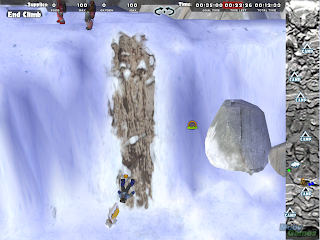FREE DOWNLOAD LAPTOP | Here's some brave hype: The front of the Everest game box proudly proclaims it to be "The ULTIMATE STRATEGY Game." Mount Everest may be the ultimate challenge for real-life climbers, but there's nothing ultimate about this mountain-climbing game, and there's hardly any strategy in it, for that matter. If Everest were freeware, it might be worth downloading for a pleasant little diversion, but it just doesn't hold up as a retail game. There's so little to it, and what it does offer is dull.
In Everest, you lead a group of climbers up simplified, tiny, cartoony versions of seven of the world's tallest peaks, like Mount McKinley, Kilimanjaro, and of course, Everest itself, unlocking them one by one with each successful climb. Before an ascent, you purchase the required number of climbers from a pool (the more skilled the climber, the more it will cost you). You then buy a single piece of equipment for each climber. (Apparently, carrying both an ice axe and first-aid kit would be too much of a burden on these rugged adventurers.) Along with buying equipment, you can pay for training that boosts three basic stats of individual climbers. After spending your allotted funds, you begin your ascent.
Each mountain is divided into several camps where your men replenish their stamina. Between each camp you face a few obstacles, which are just little patches of icy, rocky, or sheer mountain face where the actual climbing takes place. These are clearly marked on a mini-map, and the mountains are so small and simplified that there's no way to get lost, anyway. You control your little climbers from a third-person view and give them simple movement orders with mouse clicks. One click is all it takes to make a climber scale an obstacle. You don't control what equipment he uses, which footholds he selects, or anything like that--it's all simplified to the point of silliness, which equates to boredom.
In theory, Everest is a strategy game, but strategy implies tough choices and forward thinking. In that sense, Everest is barely a strategy game at all. The game usually gives you much more money than you need or can even spend. Time limits are equally generous: The game usually gives you about an hour for a climb, but a climb usually only takes fifteen or twenty minutes. Each obstacle has a different difficulty level for each climber, depending on its type, the climber's abilities, and so forth. In practice, though, almost any climber can scale any obstacle fairly easily. If he does get winded and start to struggle, you can just give him some oxygen or food to boost his stamina. Men can fall or get smacked by falling rocks, though that's rare and almost inconsequential; head injuries and broken arms barely slow these gutsy little guys down.
Only on Mount Everest itself do things get hard. The gameplay mechanics remain the same, but suddenly rocks are falling everywhere, and half your men can't scale even the earliest obstacles even though you've been training your climbers to boost their abilities. It's enough to make you quit in frustration, especially since there's no reward for actually completing a climb, just a little screen that displays your stats. By the time you actually reach Everest, you've probably already been bored by the monotonous, simplistic gameplay and the way every mountain looks and plays alike.
Either way, there's almost nothing of interest in Everest: little challenge, no excitement, and almost no thought. Perhaps Everest was conceived as something of an educational program since it bears the National Geographic logo. If that's the case, it fails miserably. Nowhere do you learn anything about climbing other than that mountaineers get cold and have to rest every once in a while. The brief information you receive about the game's seven peaks can be found online in a heartbeat or in any encyclopedia. The HTML manual includes a "History of Mount Everest" section, which turns out to be a page of text about the local Sherpa guides.
Reaching the top is tedious and offers no sense of accomplishment.
Where gameplay and education are concerned, Everest takes a bad tumble, but at least the presentation is pleasant, if simple. The graphics are cartoony, to be sure, and mountains appear to be only a couple of hundred feet high instead of twenty thousand. Still, the animations are vaguely amusing, with the little climbers adjusting their backpacks or brushing the snow off after they slip down an obstacle. Fog effects look pretty neat, too. It can be hard to enjoy these little touches, though, thanks to the sometimes-spastic camera. Everest's audio is limited to simple but effective music and sounds, like whistling wind or a climber banging an ice pick into a cliff.
The graphics may be a bit cute, but they're certainly nothing anyone would want to pay to see. Worse still, the gameplay is pretty much nonexistent since almost everything you do in Everest means eventual success, except on the final mountain. Different "strategies" have minimal impact, and climbing boils down to a series of mindless mouse clicks. In the highly unlikely event something goes really wrong on a climb, you can just restart without any penalties. There are no difficulty options, no alternate game modes, no realism settings, no multiplayer--nothing that would add depth and variety. There's barely any reason to play Everest, and certainly no reason to replay it.
SCREENSHOT
BY Agus makmur manurung





{ 0 comments... read them below or add one }
Post a Comment